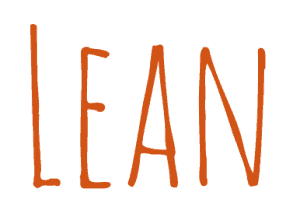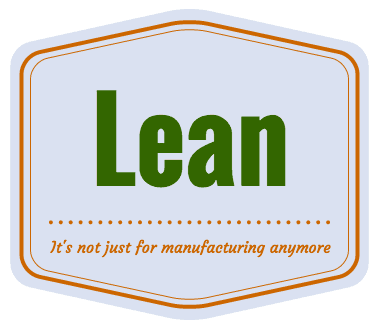New to Lean? We'll Try to Help Define Lean
… for healthcare, manufacturing, and other settings.
“Lean Healthcare” Overview:
Download the 1st Chapter of Lean Hospitals

If you're visiting the blog because of a search and you're not sure what this whole “Lean” thing is about, we'll try to introduce you. Keep in mind that this is just a starting point. There's a reason that dozens of books have been written about Lean. It's not easy to fully understand all in one night. I have been learning about it for more than 15 years 20 years since 1994. Not that I'm holding myself up as the #1 expert on the topic. I learn about Lean every day and I try to get better by “Practicing Lean.”
The Typical Goals of Lean
The goals of organizations that are practicing Lean are pretty consistent across industries. Their goals are to simultaneously improve:
- Safety
- Quality
- Delivery (reducing delays & waiting through a process)
- Cost
- Morale
The goal is to provide long-term success for an organization and for everybody involved — customers, employees, owners, suppliers, and other stakeholders.
In manufacturing, “delivery” might mean on-time delivery, or shipping the right product in the right quantity at the right time. In healthcare, it means providing the right care at the right place at the right time, which means reducing waiting times for appointments and reducing waits and delays when in a healthcare facility.
What Lean Is and Is Not
Lean is not about being skinny and it's not about “cutting to the bone.” Lean is about having the right resources in place to do the right work for the customer, with the right quality, at the right time.
Lean is not “mean” (although the words rhyme, unfortunately). Lean is respectful toward everybody who participates in a system, including customers, employees, suppliers, the community, etc.
Lean does not mean cutting heads in the name of cutting costs (see “Lean is not mean”). Lean is probably the best alternative strategy to the old approach of layoffs and “cost cutting.“
Lean is not an acronym (“LEAN”).
Lean is NOT…
- NOT just a few tools to use
- NOT a group of best practices to copy
- NOT just a bunch of projects to conduct
- NOT experts telling you what to do
- NOT a way to drive layoffs
- NOT just a process improvement methodology
- NOT just for frontline staff
- NOT “part of Six Sigma”
- NOT just about speed & efficiency
- NOT pressuring people to hit certain metrics
- NOT a silver bullet or an easy transformation
Lean is…
“Lean” is the set of management practices based on the Toyota Production System (TPS). The phrase “Lean Production” was coined by a group of MIT researchers who wrote the book The Machine That Changed the World.
Lean Production is basically the same thing as:
- Lean Manufacturing
- Lean Enterprise
- Lean Thinking
- Lean Healthcare
- Lean Government
- Lean IT
- Lean Startups
- etc.
It's the same principles and mindsets, applied for different purposes given the industry.

Lean has been applied in manufacturing (factories, product design, and administrative functions) as well as service industries (including healthcare, banking, and government). The U.S. Army has an active “lean six sigma” program underway as of 2011.
See my article on LinkedIn:
“Lean” is Not Just for Manufacturing – It Applies to Knowledge Work of All Types, Too
The Toyota Production System, a.k.a. Lean is defined as having two primary pillars:
- Just-in-Time (improving flow)
- Quality at the source
Jamie Bonini, the President of TSSC, defines TPS as:
“We define TPS as an organizational culture of highly engaged people solving problems or innovating to drive performance.”
Jamie also describes TPS as mainly a philosophy, as described in this post:
The Toyota Europe website has a page that describes the philosophy as they see it, and this page decribes the Toyota Way 2020.
Another way of defining Lean (“The Toyota Way” management system) has two parts:
- Eliminate waste and non-value-added activity (NVA) through continuous improvement
- Practice respect for people
The opposite of waste is value-added activity, which has a special Lean definition. An activity is “value added” if, and only if, these three conditions are met:
- The customer must be willing to pay for the activity
- The activity must change the “form, fit, or function” of the product, making it closer to the end product that the customer wants and will pay for (in healthcare, this can mean moving the care process forward, such as comfort, diagnosis, treatment, education, prevention)
- The activity must be done right the first time.
We aren't just reducing waste, we're also trying to provide the most value to customers through Lean methods.
In healthcare, I generally think of “value” in a patient care process to be the work that involves things like:
- Comforting the patient
- Examining them
- Diagnosing them
- Treating them
- Educating them
- Preventing future illness
Respect and Leadership
“Respect for people” is much more complex to define than it might seem. Lean isn't about “being nice” and smiling all of the time. Respect means you challenge people to do their best because you believe in them and it also means that you collaborate and work together with them in improvement (the practice of “kaizen“).
See this article about “respect for people in healthcare,” as well.
Lean leadership is about enabling and empowering people. Lean leadership is about helping people grow professionally and personally, allowing them to take pride in their work. Lean leadership recognizes how a system operates. Lean leadership doesn't set targets for people, go back to their office, and then yell at people when they don't hit those targets. Lean leaders spend time coaching people. They spend very little time in their office. They lead people and see what is actually happening rather than managing metrics and reading reports.
Much of the “people side” of lean was adapted from the teachings of the American professor and consultant W. Edwards Deming, who taught Toyota and other Japanese companies after World War II. Lean was also adapted from Toyota's study of the early practices of Henry Ford and the Ford Motor Company. Note the emphasis on “early.” Lean is not strictly a Japanese invention nor is its use limited to Japan or Japanese companies.
Lean Resources, Reading, and Listening
If you're new to Lean, welcome. I hope you'll enjoy learning more about it.
Also, check out the Lean Enterprise Institute and their “What is Lean?” pages.
Toyota's corporate website has a nice set of TPS pages. As does Toyota Europe.
I also invite you to check out my series of Lean Blog Interviews Podcast episodes, which include interviews with leading Lean thinkers, writers, and leaders.
Some of my posts on core Lean concepts and my “best posts” on this topic.
- Lean isn't about “Quality” and “Productivity”
- My Thoughts on Standardized work
- Common Sense on Offshoring and Lean
- Putting the “Continuous” Back into Continuous Improvement
This page is going to grow and evolve over time. It is hard to write a succinct definition of Lean that captures all of its principles and philosophies (but here's a post where we all tried).





